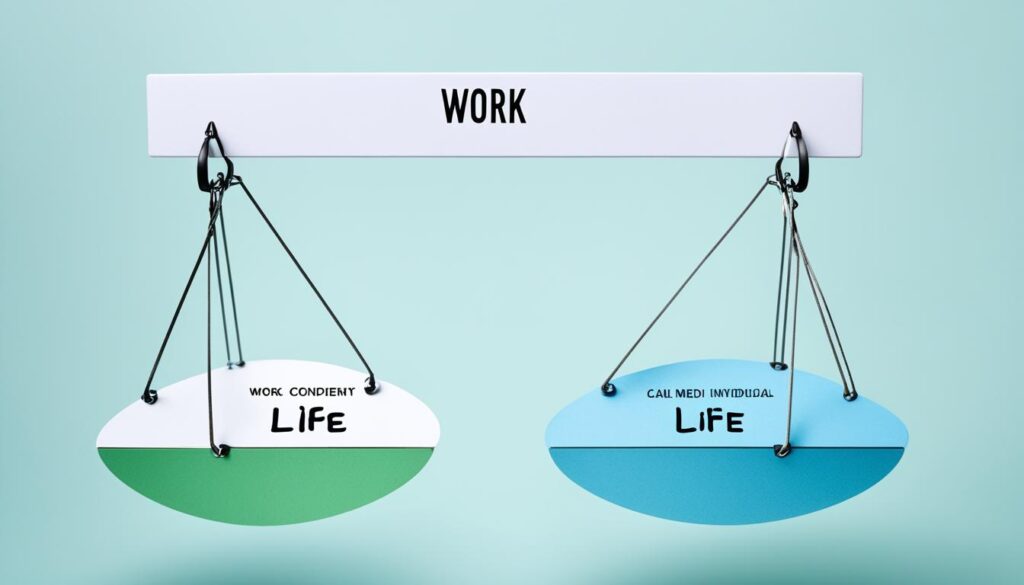Overcome Productivity Anxiety with Confidence

Do you find yourself constantly stressed about managing your time effectively? Does the pressure to excel and achieve leave you feeling anxious and overwhelmed? It’s time to challenge the common belief that productivity requires sacrificing your well-being. In this article, we will explore strategies to overcome productivity anxiety and create a harmonious work-life balance.
Key Takeaways:
- Productivity anxiety is a common challenge faced by professionals.
- Self-reflection and awareness are essential for understanding the underlying causes of productivity anxiety.
- Setting realistic goals and priorities helps alleviate anxiety and fosters a positive mindset.
- Effective time management techniques, such as the Pomodoro Technique and time blocking, can enhance productivity.
- Establishing healthy work-life boundaries promotes a balanced and fulfilling life.
Self-Reflection and Awareness
Self-reflection is an essential tool in overcoming productivity anxiety. By taking the time to reflect on your thoughts and emotions, you gain a deeper understanding of the underlying causes and triggers of your anxiety. This self-awareness allows you to take control of your emotions and develop effective strategies to cope with productivity anxiety.
One powerful method of self-reflection is journaling. By regularly writing down your thoughts, you can identify patterns, uncover hidden fears, and gain clarity on what truly matters to you. Journaling provides a safe space to express your emotions and reflect on your experiences, promoting self-discovery and personal growth.
In addition to journaling, mindfulness and meditation practices can help cultivate self-awareness. By focusing on the present moment and observing your thoughts and feelings without judgment, you develop a greater understanding of how your mind works and how it affects your productivity. Mindfulness can also help you recognize and manage anxiety triggers, allowing you to respond more effectively and reduce stress.
Engaging in conversations with trusted individuals can also provide valuable insight and support during your self-reflection journey. Discussing your challenges, fears, and goals with a friend, mentor, or therapist can offer a fresh perspective and help you gain new insights into your productivity anxiety. These conversations can also provide emotional support and encouragement, reminding you that you are not alone in your struggles.

Tips for Self-Reflection and Awareness:
- Set aside dedicated time each day or week for self-reflection and mindfulness practices.
- Keep a journal and regularly write down your thoughts, emotions, and reflections.
- Practice mindfulness or meditation to cultivate self-awareness and reduce stress.
- Seek support through conversations with trusted individuals who can offer guidance and a different perspective.
Setting Realistic Goals and Priorities
When it comes to managing productivity anxiety, setting realistic goals and priorities is absolutely crucial. It’s important to acknowledge that you are only human, and you have limitations. By breaking down your tasks into smaller, more manageable steps, you can alleviate anxiety and build momentum.
Start by identifying your most important tasks and prioritizing them based on their urgency and impact. This allows you to focus your energy where it matters most, giving you a sense of control and direction. Remember, you don’t have to do it all at once. Taking small, intentional steps towards your goals will lead to meaningful progress.
Celebrating your progress along the way is equally important. No matter how small the achievement may seem, acknowledge and appreciate it. Celebrating small victories boosts your motivation and confidence, reminding you that you are making progress. Embrace the journey and be proud of every step you take towards your goals.
Adopting a mindset that focuses on progress rather than perfection is a powerful strategy to reduce productivity anxiety. Acknowledge that perfection is an unrealistic expectation and that progress is what truly matters. Celebrate your growth, even if it’s not flawless. Embrace imperfection and be kind to yourself along the way.
Remember, you are on a journey of growth and improvement. By setting realistic goals, prioritizing tasks, and celebrating progress, you can foster a positive mindset and reduce anxiety. Allow yourself the space to grow, learn, and enjoy the process of achieving your goals.
Time Management Techniques
Effective time management is key to reducing productivity anxiety. By implementing proven techniques, you can optimize your productivity and achieve your goals more efficiently. Two highly effective strategies are the Pomodoro Technique and time blocking. Let’s explore how you can leverage these techniques to overcome productivity anxiety and regain control of your time.
Pomodoro Technique
The Pomodoro Technique is a time management method that involves breaking your work into focused intervals, typically 25 minutes long, followed by short breaks of 5 minutes. Each focused interval is called a “Pomodoro.” This technique helps you maintain concentration, increase productivity, and prevent burnout. By working in short bursts, you give yourself permission to take regular breaks, which refreshes your mind and enhances your ability to focus during work sessions.

Time Blocking
Time blocking is a powerful strategy for managing your schedule and priorities. With time blocking, you allocate specific time slots for different tasks or activities. By designating dedicated blocks of time for specific work, you can focus on important tasks without distractions. This technique also helps you avoid the temptation of multitasking, ensuring that you give each task the attention it deserves. Time blocking allows for better planning, reduces decision fatigue, and improves overall productivity.
Eliminate Non-Essential Tasks
Streamlining your to-do list is essential for effective time management. Take a critical look at your tasks and identify non-essential or low-priority items. Delegate tasks when possible and eliminate those that don’t align with your goals or add significant value. By freeing up time from non-essential tasks, you create space for meaningful work and relaxation. This reduction in unnecessary obligations reduces stress and anxiety, allowing you to focus on what truly matters.
Establishing Healthy Work-Life Boundaries
Maintaining a healthy work-life balance is crucial for overcoming productivity anxiety. When work encroaches on personal life or vice versa, it can lead to increased stress and decreased overall well-being. By establishing clear working hours and boundaries, you can create a harmonious balance between your professional and personal life.
Setting Clear Working Hours
One of the first steps in maintaining work-life balance is to define and communicate your working hours. This is especially important in a remote work setting, where the lines between work and personal life can become blurred. By setting clear working hours, you establish boundaries that prevent overworking and promote a healthier work-life integration.
Creating a Dedicated Workspace
A dedicated workspace is essential for maintaining focus and separating work life from personal life. Having a designated area where you can fully concentrate on your tasks helps to increase productivity and reduce distractions. It also signals to yourself and others that when you’re in that space, you’re in work mode.
Scheduling Self-Care Activities
Self-care activities are crucial for your overall well-being and can play a significant role in reducing productivity anxiety. Scheduling time for activities that help you recharge and relax, such as exercise, hobbies, or spending quality time with loved ones, is important for maintaining a balanced and fulfilling life. By prioritizing self-care, you are better equipped to handle work-related stress and maintain your productivity levels.

| Benefits of Establishing Healthy Work-Life Boundaries | Tips for Maintaining Work-Life Balance |
|---|---|
| 1. Reduced stress and anxiety | 1. Prioritize and delegate tasks |
| 2. Increased productivity and focus | 2. Avoid overcommitting to work |
| 3. Enhanced physical and mental well-being | 3. Set realistic expectations |
| 4. Improved relationships | 4. Take regular breaks |
| 5. Greater work satisfaction | 5. Communicate boundaries with colleagues |
Table: Benefits of Establishing Healthy Work-Life Boundaries and Tips for Maintaining Work-Life Balance
Conclusion
Productivity anxiety may be a common challenge, but it can be overcome with the right strategies. By implementing self-reflection and awareness, setting realistic goals and priorities, utilizing time management techniques, establishing healthy work-life boundaries, and embracing imperfection and self-compassion, you can conquer productivity anxiety and lead a more balanced life.
It is important to remember that productivity limits vary from person to person, and pushing beyond those limits can lead to burnout. By prioritizing self-care and understanding your own productivity limits, you can effectively combat work-related stress and achieve a harmonious work-life balance.
Remember, productivity is not the sole measure of success. Taking breaks, engaging in self-care activities, and spending quality time with loved ones are equally important in leading a fulfilling life. By embracing a holistic approach to productivity and well-being, you can overcome productivity anxiety and find joy and fulfillment in all aspects of your life.
FAQ
What is productivity anxiety?
Productivity anxiety is the stress and pressure individuals feel to constantly excel and achieve, leading to feelings of anxiety and overwhelm in their work or personal lives.
What are some common triggers of productivity anxiety?
Productivity anxiety can be triggered by societal expectations, perfectionism, fear of failure, and the need for external validation.
How can self-reflection and awareness help in overcoming productivity anxiety?
Self-reflection and awareness through journaling, mindfulness, and seeking support can help individuals better understand the causes and triggers of their anxiety, allowing them to develop coping strategies.
Why is setting realistic goals and priorities important in managing productivity anxiety?
Setting realistic goals and priorities helps alleviate anxiety by breaking tasks into smaller steps and focusing on progress rather than perfection.
What time management techniques can help reduce productivity anxiety?
Time management techniques such as the Pomodoro Technique, time blocking, and eliminating non-essential tasks can enhance productivity and reduce stress.
How can establishing healthy work-life boundaries contribute to overcoming productivity anxiety?
Establishing clear working hours, creating a dedicated workspace, and scheduling self-care activities help maintain a healthy work-life balance, preventing burnout and reducing anxiety.





